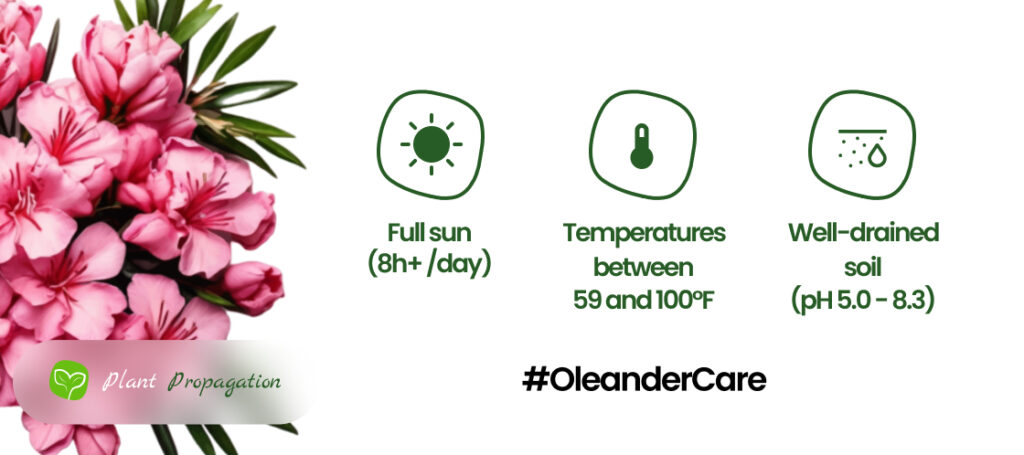
Welcome to our guide on How to Prune Oleanders the right way! While it’s not a must-do, giving your oleanders a trim can work wonders for their appearance and growth. In this guide, we’ll walk you through everything you need to know about pruning these beauties. From the best timing to essential tools and techniques, we’ve got all the tips and tricks to keep your oleanders thriving and looking their best.
Do you need to prune Oleanders?
Before we dive into the specifics of how to prune oleander, let’s cover some basics. Pruning oleander shrubs isn’t a must for their health, but it does help keep them in check and looking neat. While your oleander can do just fine without regular trims, it’s worth considering if you want to control its growth and maintain its appearance.
Timing and technique play a big role when it comes to pruning oleanders. Knowing when to prune and how to do it properly ensures you get the best results without harming your plant. So, while it’s not absolutely necessary, giving your oleander a trim now and then can keep it thriving and looking its best!
When to Prune Oleanders
Oleanders should ideally get their trim in late summer or early fall. Why? Well, by this time, they’ve already put on their blooming show for the season. So, you can snip away without worrying about ruining their floral display. But here’s the deal: don’t procrastinate past October! Pruning too late leaves your freshly trimmed oleander bits vulnerable to frost. And trust me, a chilly surprise is the last thing your plants need.
So, mark your calendars and aim to give your oleanders a trim before autumn’s crisp air sets in. Your plants will thank you for the timely makeover, and you’ll get to enjoy a thriving, healthy garden all year round!
Tools You’ll Need
When it comes to pruning anything, having the right tools at hand is key. Here are the must-haves for pruning Oleanders:
- Pruning Shears: These are your go-to for trimming smaller branches and stems with precision.
- Loppers: For those thicker branches that pruning shears can’t handle, loppers come to the rescue. They give you the leverage you need to make clean cuts without breaking a sweat.
- Pruning Saw: When you’re dealing with really thick branches or old, stubborn growth, a pruning saw is your best friend. It slices through wood like butter, and it is also the most precise tool you can have for pruning.
- Protective Gloves: Last but not least, don’t forget to gear up with a sturdy pair of protective gloves. They’ll keep your hands safe from scratches, thorns, and any other surprises lurking in your oleander bushes.
With these tools in your arsenal, you’ll be ready to tackle any pruning task that comes your way.

How to Prune Oleander
Now, let’s get into the nitty-gritty of how to prune oleander. Follow these steps for effective pruning:
- Inspect the Plant: Start by inspecting the oleander plant for dead or damaged branches. These should be removed first to promote healthy growth.
- Remove Suckers: Look for any suckers or shoots growing from the base of the plant and remove them. These can divert energy away from the main plant.
- Thin Out Branches: Thin out crowded or crossing branches to improve air circulation and light penetration throughout the plant.
- Shape the Plant: Use pruning shears or loppers to shape the oleander plant according to your desired shape and size. Make cuts at a 45-degree angle just above a node or bud.
- Clean Up: Once you’ve finished pruning, clean up the area around the plant by removing any pruned branches and foliage. Proper disposal helps prevent the spread of diseases and pests.
Pruning Oleander in Spring
Springtime is the perfect season to show your oleander some TLC. Here’s your to-do list for sprucing it up:
- Choose an early date: Kickstart the growing season by pruning your oleander early in spring.
- Cut shoots back: When trimming, don’t just snip the tips—cut back shoots that are too long to the next shoot. This encourages healthy bud development for future blooms.
- Keep an eye out in summer: Trim any rogue shoots you spot during the summer to prevent your oleander from getting too wild.
- Leave the fruits: After flowering, let those little fruits be. They’re like tiny promise packages for next year’s blooms.
Follow these steps, and your oleander will thank you with a season of vibrant growth and blossoms!
Pruning Oleander in Autumn
Autumn rolls around, and it’s time to get a bit more daring with your oleander pruning. Here’s your game plan for this season:
- Radical pruning: It’s time to get down to business! Cut those branches back to 40-50 cm, especially if you’ve got older oleander plants that are starting to show their age. Don’t be afraid to bring out the saw if needed!
- Thin out the base: Those thinner branches? They can go all the way down to the base. This helps thin out the plant and keeps it looking fresh.
- Check the roots: Before you go all Edward Scissorhands on your oleander, make sure its roots are up for the challenge. If they seem a bit weak, give your plant a boost by repotting it in some fresh soil first.
- Handle disease with care: If you’ve got a diseased oleander on your hands, don’t panic. Just prune it back as far as the disease has spread. No need to go overboard!
Aftercare
If you’ve pruned your Oleander in the spring, it will bounce back pretty fast no problem. The only thing you need to do is do a bit of watering and watch out for any signs of pests or diseases. If you’ve done pruning in Autumn, a bit of fertilizing can come in handy to help the fast regeneration. Other than that, Oleanders are not very needy.

Frequently Asked Questions
When should oleanders be cut back?
Oleanders should ideally be cut back in late summer or early fall. This timing won’t mess with the blooming show because it happens after their blooming season. Don’t delay past October! Pruning too late leaves the freshly trimmed bits exposed and vulnerable to frost.
How do you prune overgrown oleanders?
To handle overgrown oleanders, heavily prune select branches halfway down to stimulate new growth. Young oleanders can be cut to the ground in fall to promote bushier growth in spring.
How far can you cut back oleanders?
Aim to snip oleander stems to about half the height you’d like for the whole plant. If your oleander’s towering over the place and causing trouble, don’t hold back—cut it down to size! Remember, pruning oleanders actually perks up growth and branching.
How often should I prune my oleander plant?
If you want to keep your Oleander at a certain size, you should prune it annually. If you want to let it grow, annual pruning is not necessary.
Should you deadhead oleander?
Absolutely! Deadhead those spent oleander flowers to encourage fresh blooms. But hold off until fall after the peak bloom to give it a trim.

